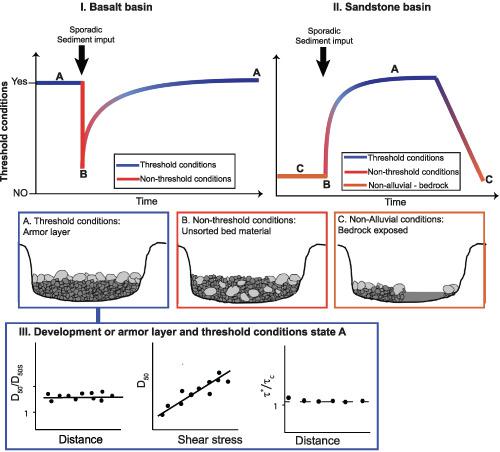当前位置:
X-MOL 学术
›
Earth Surf.Process. Land.
›
论文详情
Our official English website, www.x-mol.net, welcomes your feedback! (Note: you will need to create a separate account there.)
The influence of lithology on channel geometry and bed sediment organization in mountainous hillslope‐coupled streams
Earth Surface Processes and Landforms ( IF 3.3 ) Pub Date : 2020-06-14 , DOI: 10.1002/esp.4885 Michael Mulugetta Fratkin 1, 2 , Catalina Segura 1 , Sharon Bywater‐Reyes 3
Earth Surface Processes and Landforms ( IF 3.3 ) Pub Date : 2020-06-14 , DOI: 10.1002/esp.4885 Michael Mulugetta Fratkin 1, 2 , Catalina Segura 1 , Sharon Bywater‐Reyes 3
Affiliation

|
Sediment transport and channel morphology in mountainous hillslope‐coupled streams reflect a mixture of hillslope and channel processes. However, the influence of lithology on channel form and adjustment and sediment transport remains poorly understood. Patterns of channel form, grain size, and transport capacity were investigated in two gravel‐bed streams with contrasting lithology (basalt and sandstone) in the Oregon Coast Range, USA, in a region in which widespread landslides and debris flows occurred in 1996. This information was used to evaluate threshold channel conditions and channel bed adjustment since 1996. Channel geometry, slope, and valley width were measured or extracted from LiDAR and sediment textures were measured in the surface and subsurface. Similar coarsening patterns in the first few kilometres of both streams indicated strong hillslope influences, but subsequent downstream fining was lithology‐dependent. Despite these differences, surface grain size was strongly related to shear stress, such that the ratio of available to critical shear stress for motion of the median surface grain size at bankfull stage was around one over most of the surveyed lengths. This indicated hydraulic sorting of supplied sediment, independent of lithology. We infer a cycle of adjustment to sediment delivered during the 1996 flooding, from threshold conditions, to non‐alluvial characteristics, to threshold conditions in both basins. The sandstone basin can also experience complete depletion of the gravel‐size alluvium to sand size, leading to bedrock exposure because of high diminution rates. Although debris flows being more frequent in a basalt basin, this system will likely display threshold‐like characteristics over a longer period, indicating that the lithologic control on channel adjustment is driven by differences in rock competence that control grain size and available gravel for bed load transport. © 2020 John Wiley & Sons, Ltd.
中文翻译:

岩性对山坡耦合流河道几何及床层沉积物组织的影响
山区山坡耦合流中的泥沙输运和河道形态反映了山坡和河道过程的混合。但是,人们对岩性对河道形态和调整以及泥沙输送的影响知之甚少。在美国俄勒冈海岸山脉,1996年发生了广泛的滑坡和泥石流的地区,研究了两种具有相反岩性的砾石床流(玄武岩和砂岩)的河道形式,晶粒大小和输送能力的模式。自1996年以来,该信息用于评估阈值通道条件和通道床调整。从LiDAR测量或提取了通道的几何形状,坡度和谷宽,并测量了表层和地下的沉积物质地。两条河流的前几公里中相似的粗化模式表明强烈的坡度影响,但随后的下游精细化取决于岩性。尽管存在这些差异,但表面晶粒尺寸与剪切应力密切相关,因此,在整个测量的长度范围内,堤岸满期阶段中位表面晶粒尺寸的运动可利用的临界应力与临界剪切应力之比约为1。这表明所提供的沉积物的水力分选与岩性无关。我们推断出对1996年洪水期间沉积物的调整周期,从阈值条件到非冲积特征,再到两个盆地的阈值条件。砂岩盆地也可能经历砾石大小冲积层完全枯竭至沙粒大小的情况,由于减小率高,导致基岩暴露。尽管玄武岩盆地中的泥石流更为频繁,但该系统可能会在更长的时间内显示出类似阈值的特征,这表明对通道调整的岩性控制是由岩石能力的差异所驱动的,该差异控制着晶粒大小和可用于床荷的砾石运输。分级为4 +©2020 John Wiley&Sons,Ltd.
更新日期:2020-06-14
中文翻译:

岩性对山坡耦合流河道几何及床层沉积物组织的影响
山区山坡耦合流中的泥沙输运和河道形态反映了山坡和河道过程的混合。但是,人们对岩性对河道形态和调整以及泥沙输送的影响知之甚少。在美国俄勒冈海岸山脉,1996年发生了广泛的滑坡和泥石流的地区,研究了两种具有相反岩性的砾石床流(玄武岩和砂岩)的河道形式,晶粒大小和输送能力的模式。自1996年以来,该信息用于评估阈值通道条件和通道床调整。从LiDAR测量或提取了通道的几何形状,坡度和谷宽,并测量了表层和地下的沉积物质地。两条河流的前几公里中相似的粗化模式表明强烈的坡度影响,但随后的下游精细化取决于岩性。尽管存在这些差异,但表面晶粒尺寸与剪切应力密切相关,因此,在整个测量的长度范围内,堤岸满期阶段中位表面晶粒尺寸的运动可利用的临界应力与临界剪切应力之比约为1。这表明所提供的沉积物的水力分选与岩性无关。我们推断出对1996年洪水期间沉积物的调整周期,从阈值条件到非冲积特征,再到两个盆地的阈值条件。砂岩盆地也可能经历砾石大小冲积层完全枯竭至沙粒大小的情况,由于减小率高,导致基岩暴露。尽管玄武岩盆地中的泥石流更为频繁,但该系统可能会在更长的时间内显示出类似阈值的特征,这表明对通道调整的岩性控制是由岩石能力的差异所驱动的,该差异控制着晶粒大小和可用于床荷的砾石运输。分级为4 +©2020 John Wiley&Sons,Ltd.


























 京公网安备 11010802027423号
京公网安备 11010802027423号